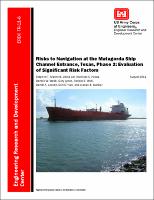Please use this identifier to cite or link to this item:
https://hdl.handle.net/11681/8573| Title: | Risks to navigation at the Matagorda Ship Channel Entrance, Texas. Phase 2, Evaluation of significant risk factors |
| Authors: | Maynord, Stephen T. Lin, Lihwa Kraus, Nicholas C. Webb, Dennis W. Lynch, Gary C. Wahl, Ronald E. Leavell, Daniel A. Yule, Donald E. Dunbar, Joseph B. |
| Keywords: | Asymetric currents Deep-draft navigation channel Flanking and slope failures Grounding Matagorda ship channel Texas Navigation risk assessment Inland navigation |
| Publisher: | Engineer Research and Development Center (U.S.) |
| Series/Report no.: | Technical report (Engineer Research and Development Center (U.S.)) ; no.ERDC TR-11-8 |
| Abstract: | The Phase 1 Matagorda study (Maynord et al. 2007) examined eight factors to identify which factors pose a significant risk of disrupting navigation at the Matagorda Ship Channel (MSC) entrance. Three factors were identified that warranted further study of the risk of disrupting navigation. These three factors were flanking of the jetty and slope protection, strong and asymmetric currents on the bay side of the peninsula and in the bottleneck (constricted portion of the entrance channel), and slope failures that constrict the channel, create adverse currents for navigation, or lead to shoaling of the channel. The risk factor of flanking and breaching of the jetty and slope protection was found to have a minimal risk of disrupting navigation because the cross current through the breach is weak compared to the longitudinal current in the navigation channel. The risk factor of slope failure from the continuing scour of the channel bottom will have a minimal risk of disrupting navigation because the size of the slope failures are not large enough to disrupt currents or cause shoaling problems. However, slope failures will increase in frequency and severity due to the continuing scour of the bottleneck. The risk factor of strong and asymmetric currents poses a significant risk of grounding in the existing navigation channel. In the bottleneck, surface currents at the center of the channel equal or exceed 3 knots more than 60 percent of the time and equal or exceed 5 knots 20 percent of the time. Based on expert elicitation of the pilots, the reach between the bottleneck and Sundown Island (B SI) is the reach most likely to experience a powered grounding. A ship simulator was used to evaluate the effects of removal of the bottleneck. The Phase 2 MSC study recommends use of a “current window” that limits navigation to periods when current in the bottleneck is less than 5 knots. Daylight restricting all deep draft navigation should be considered. If the 5-knot current window and daylight restriction of all navigation cause unacceptable restrictions on navigation, the structural alternative of bottleneck removal will significantly reduce the likelihood of a powered grounding at the MSC Entrance. Relocation of Sundown Island should reduce adverse cross current effects in the bay. |
| Description: | Technical Report |
| Gov't Doc #: | ERDC TR-11-8 |
| Rights: | Approved for public release; distribution is unlimited |
| URI: | http://hdl.handle.net/11681/8573 |
| Appears in Collections: | Technical Report Technical Report |
